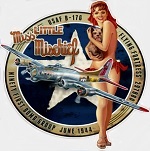Corgi AA33316 USAAF Boeing B-17G-35-VE Flying Fortress Heavy Bomber - "Little Miss Mischief", 324th Bombardment Squadron, 91st Bombardment Group "Ragged Irregulars", Bassingbourn, England, 1944 (1:72 Scale)
"Well, I can tell you right now what the problem is. I saw it in your faces last night. I can see it there now. You've been looking at a lot of air lately, and you feel you need a rest. In short, you're feeling sorry for yourselves. Now I don't have a lot of patience with this "What are we fighting for?" stuff. We're in a war, a shooting war. We've got to fight. And some of us have got to die!"
- General Frank Savage, from the feature film "Twelve O'Clock High"
 The B-17, arguably World War II's most famous heavy bomber, first flew on July 28th, 1935, before a crowd of reporters eager to see Boeing's new bomber take wing. It was dubbed the "Flying Fortress" by the members of the press in attendance because of its (at least for the time) heavy defensive armament. The prototype crashed in October, but because of its impressive speed and handling the US Army Air Corps (USAAC) decided to continue testing anyway. They ordered 13 YB-17s for further evaluation, a decision that would prove momentous in years to come.
The B-17, arguably World War II's most famous heavy bomber, first flew on July 28th, 1935, before a crowd of reporters eager to see Boeing's new bomber take wing. It was dubbed the "Flying Fortress" by the members of the press in attendance because of its (at least for the time) heavy defensive armament. The prototype crashed in October, but because of its impressive speed and handling the US Army Air Corps (USAAC) decided to continue testing anyway. They ordered 13 YB-17s for further evaluation, a decision that would prove momentous in years to come.
The YB-17 had five machine guns, room for 4,800 pounds of bombs and a crew of nine. It had electrically retractable landing gear. After testing the YB-17, an improved prototype, the Y1B-17, was built with Wright Cyclone radial engines. Twelve were delivered to the USAAC's 2nd Bombardment Group for trials. One of these was soon equipped with new Moss/General Electric turbochargers that became standard on all future Flying Fortresses. The first production order was for 39 B-17Bs with turbo-charged engines, and as soon as these were under production another order for the B-17C was placed, with seven machine guns instead of the original five.
The RAF received their first B-17Cs in 1941, and were soon conducting daylight raids over Germany. The defensive armament soon proved inadequate, and the B-17's altitude was little defense against the German fighters. Orders for the B-17D were soon placed with self-sealing fuel tanks and more armor because of lessons learned in bombing missions over Europe. The B-17E and B-17F soon followed with larger tail. The B-17F was the first to serve with the USAAF 8th Air Force. After suffering staggering losses in late 1943, analysis proved head-on attacks by enemy fighters were a distinct problem. The final major version, the B-17G, added a chin turret with dual machineguns. This gave the B-17 a defensive armament of 13 guns.
After the war, several dozen B-17s lived on as fire-bombers and aerial surveyors until the last one was retired in the 1970s. Today, a few B-17s have been restored to their wartime splendor. Ten are currently flying in the United States, one in the UK and another one in France. Features extremely high level of details including full crew, rotating gun turrets, working undercarriage, and bomb load.
This particular 1:72 scale replica of a B-17G-35-VE Flying Fortress heavy bomber was nicknamed "Little Miss Mischief", and attached to the 324th Bombardment Squadron, 91st Bombardment Group, then stationed at Bassingbourn, Cambridgeshire, England, during 1944.
Sold Out!
Dimensions:
Wingspan: 17-1/2-inches
Length: 12-1/4-inches
Release Date: November 2017
 Historical Account: "Mash Up" - "Little Miss Mischief" was an all silver B-17G built by Vega. During a mission, she was severely damaged. Large portions of her rear fuselage were holed, her rudder and tail planes were partially shot away, and the ball turret was mostly destroyed and the ball turret gunner was trapped inside. The pilot had to grab the control cables in order to allow the plane to return to England. That's how badly shot up she was.
Historical Account: "Mash Up" - "Little Miss Mischief" was an all silver B-17G built by Vega. During a mission, she was severely damaged. Large portions of her rear fuselage were holed, her rudder and tail planes were partially shot away, and the ball turret was mostly destroyed and the ball turret gunner was trapped inside. The pilot had to grab the control cables in order to allow the plane to return to England. That's how badly shot up she was.
Once on the ground, the plane was going to be scrapped, but the maintenance chief had a salvaged rear fuselage from another B-17G that he decided to use. So "Little Miss Mischief" went back into service as a conglomeration of several different B-17s. Her new rear fuselage was all early B-17G made by Boeing, hence why the strange paint scheme. Once repaired she went on to fly 15 more missions before she crash landed in England (again) in August 1944 and was finally scrapped.









